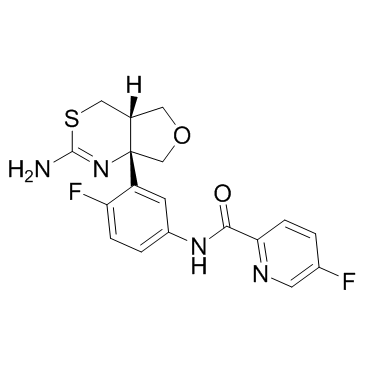LY 2886721 Hydrochloride

LY 2886721 Hydrochloride structure
|
Common Name | LY 2886721 Hydrochloride | ||
|---|---|---|---|---|
| CAS Number | 1262036-49-6 | Molecular Weight | 426.87 | |
| Density | N/A | Boiling Point | N/A | |
| Molecular Formula | C18H17ClF2N4O2S | Melting Point | N/A | |
| MSDS | N/A | Flash Point | N/A | |
Use of LY 2886721 HydrochlorideLY2886721 hydrochloride is a potent, selective and orally active beta-site amyloid precursor protein cleaving enzyme 1 (BACE1) inhibitor with an IC50 of 20.3 nM for recombinant human BACE1. LY2886721 hydrochloride is selectivity against cathepsin D, pepsin, and renin, but lacking selectivity against BACE2 (IC50 of 10.2 nM). LY2886721 hydrochloride can across blood-brain barrier and has the potential for Alzheimer's disease treatment[1]. |
| Name | N-[3-[(4aS,7aS)-2-amino-4,4a,5,7-tetrahydrofuro[3,4-d][1,3]thiazin-7a-yl]-4-fluorophenyl]-5-fluoropyridine-2-carboxamide,hydrochloride |
|---|---|
| Synonym | More Synonyms |
| Description | LY2886721 hydrochloride is a potent, selective and orally active beta-site amyloid precursor protein cleaving enzyme 1 (BACE1) inhibitor with an IC50 of 20.3 nM for recombinant human BACE1. LY2886721 hydrochloride is selectivity against cathepsin D, pepsin, and renin, but lacking selectivity against BACE2 (IC50 of 10.2 nM). LY2886721 hydrochloride can across blood-brain barrier and has the potential for Alzheimer's disease treatment[1]. |
|---|---|
| Related Catalog | |
| Target |
IC50: 20.3 nM (Beta-site amyloid precursor protein cleaving enzyme 1 (BACE1)); 10.2 nM (BACE2)[1] |
| In Vitro | Overnight exposure of HEK293Swe cells to increasing concentrations of LY2886721 hydrochloride shows a concentration-dependent decrease in the amount of Aβ secreted into the condition medium. Consistent with a mechanism of BACE inhibition, the EC50s for inhibition of Aβ1-40 and Aβ1-42 are essentially identical, 18.5 and 19.7 nM, respectively[1]. Overnight exposure of PDAPP neuronal cultures to an increasing concentration of LY2886721 hydrochloride produces a concentration-dependent decrease in Aβ production. As observed in HEK293Swe cells, the EC50s for inhibition of Aβ1-40 and Aβ1-42 are comparable in PDAPP neuronal cultures at ~10 nM[1]. |
| In Vivo | LY2886721 hydrochloride (3-30 mg/kg; oral administration; PDAPP mice) treatment significantly reduces the hippocampal and cortical levels of Aβ1-x. LY2886721 hydrochloride treatment results in significant reduction of brain parenchymal levels of C99 and sAPPβ[1]. |
| References |
| Molecular Formula | C18H17ClF2N4O2S |
|---|---|
| Molecular Weight | 426.87 |
| Exact Mass | 426.07300 |
| PSA | 112.40000 |
| LogP | 4.02850 |
|
~93% 
LY 2886721 Hydr... CAS#:1262036-49-6 |
| Literature: ELI LILLY AND COMPANY Patent: US2011/9395 A1, 2011 ; Location in patent: Page/Page column 33 ; |
|
~% 
LY 2886721 Hydr... CAS#:1262036-49-6 |
| Literature: ELI LILLY AND COMPANY Patent: US2011/9395 A1, 2011 ; Location in patent: Page/Page column 33 ; |
| Precursor 1 | |
|---|---|
| DownStream 1 | |
| unii-hw8gjy7v7r |

